MY
FRIEND SKELETON
VERSIONE
ITALIANA
Intervista
by Anialf
Credevo
di aver visto ed ascoltato ormai tutto, nei miei (come tutti ormai
sanno) tanti anni di 'militanza' nella scena gotica: errore, mai essere
presuntuosi a priori, c'è (e spero ci sarà) sempre qualcosa
di nuovo da imparare. E chi ha avuto l'eccellente quanto inquietante
idea di avvicinarsi ai “My Friend Skeleton”, miei ospiti in questa
intervista, e al loro ultimo lavoro 'Vanitas', mi darà immediatamente
ragione. Basta così, ora le domande, che non saranno mai abbastanza...
anche perché questa non è solo un'intervista, ma contemporaneamente
sarà anche una recensione del doppio cd…
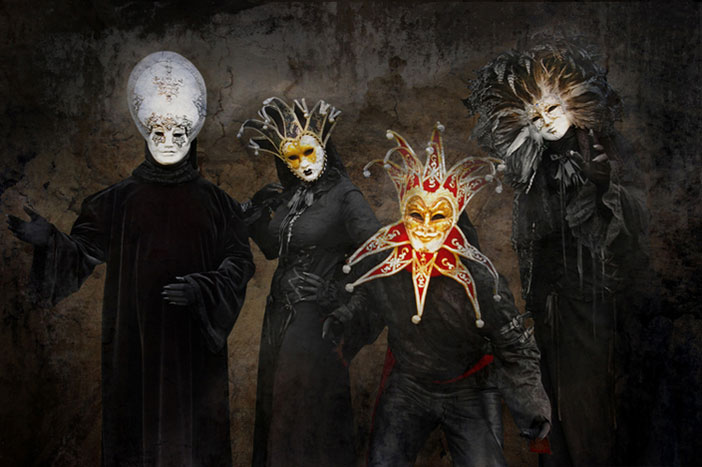
Anzitutto,
grazie in anticipo per la chiacchierata. Come ho scritto in apertura,
a 45 anni, di cui la metà trascorsi nell'ambiente delle sonorità
"gotiche" (perdonatemi il termine assai generico), pensavo sarebbe
stato molto arduo trovare qualcosa di realmente originale e soprattutto
così coinvolgente a livello emotivo. Per cui la prima domanda
sarà anche la più banale: chi (o 'cosa') sono realmente
i "My Friend Skeleton"? Come avete iniziato e con quali motivazioni
e prospettive? Da quale luogo provenite, sia fisico che immaginifico?
Archimed:
Ok, penso che inizierò dalla più facile. Siamo (o eravamo)
creature della Terra, terzo pianeta del sistema solare vicino a Proxima
Centaury :-) No, a parte gli scherzi, le radici di tutti i membri
della famiglia Skeleton sono alquanto diverse. Siamo tutti europei,
ma non ci sentiamo limitati in questo. E ciò è uno dei
motivi per cui indossiamo le maschere: non vogliamo che la gente si
limiti ad interessarsi sul nostro passato o le nostre origini. – vogliamo
semplicemente comunicare attraverso la nostra arte. Non appena avremo
stabilito questa modo di comunicare, riveleremo molti più particolare
delle nostre origini.
I
membri fondatori della famiglia Skeleton si incontrarono alcuni anni
fa. Volevamo creare una famiglia artistica nella quale i componenti
fossero legati più dal senso comune dell’Arte piuttosto che
dai vincoli di sangue. Iniziammo con Amaya, Kay Ozz, Serena, Violetta
ed io. E come in ogni famiglia artistica, ci fu un costante ricambio
di persone - Serena e Violetta restarono durante la preparazione di
“Vanitas”, Leontes ci fece visita per breve tempo, Asuveideto attualmente
suona le percussioni, e ci sono altri membri che saranno presentati
nei futuri progetti. Quindi c’è sempre una fonte per molti progetti
diversi: My Friend Skeleton and My Skeleton Friend –
ovviamente quelli predominanti – sono solo i primi di una speriamo
lunga lista di collaborazioni a venire: talvolta si tratterà
di una specie di gita familiare, alter volte saranno progetti più
privati con solo un fratello o una sorella.
Sarò
onesto: ho aperto il Vostro special-box intuendone da subito l'arcano
contenuto, ma mai mi sarei aspettato un capolavoro del genere, una
gioia/tormento visivi ed acustici. Poi ho visto l'etichetta della
Danse Macabre e ho pensato <<Bruno Kramm... chi altro?>>
e ho visto la sua introduzione in prima pagina: ditemi, come ha agito
la sua lucida follia creativa nell’album, Vi ha direttamente ed in
prima persona aiutato a realizzare "Vanitas", o è intervenuto
solo come produttore? Vi ha anche 'scoperto' lui, come si dice in
gergo, visto che non sarebbe la prima volta che il suo istinto lo
porta lontano, e come siete entrati in contatto con lui?
Kay
Ozz: Abbiamo creato e prodotto l’album in autonomia. Ma sin dall’inizio
della nostra collaborazione con lui, Bruno ci ha veramente aiutati
con le nostre idee. E’ stato bello vedere che le nostre intenzioni
trovavano in lui terreno fertile, e così successe che Bruno
scrisse l’intro del nostro libro. Siamo stati contenti di questo,
perché lo apprezziamo molto ed abbiamo apprezzato il suo supporto.
A
leggere il meraviglioso book allegato al box (di cui parlerò
più avanti) si direbbe che, nonostante appariate come una band,
dietro ai 'M.F.S.' ci sia di fatto principalmente Archimed, a cui
le altre persone hanno apportato il loro fondamentale contributo:
ho capito bene, o comunque 'Vanitas' è stato in ogni caso un
lavoro abbastanza paritetico?
Archimed:
Non vorrei definirmi la persona principale dietro ai “My Friend Skeleton”,
ma a causa del fatto che ci siamo suddivisi i ruoli in modo preciso,
posso aver avuto la parte di maggior influenza. Essendo un musicista
e compositore ricordo bene che la mia parte di lavoro fu quella di
costruire ed abbellire, arricchendole, tutte le incredibili storie
che Amaya voleva raccontare. E senza il fantastico talento vocale
di Kay Ozz ed il suo differente approccio musicale, My Skeleton Friend
(il nostro alter-ego nella seconda parte di “Vanitas”) ciò
non sarebbe mai stato possibile.
Così
come per comporre la musica per ‘Vanitas’, io ho sempre bisogno
di spazio e tempo prima di costruire i paesaggi anche per le storie..
Lo scrivere musica ha molto in comune con lo scrivere per film o libri.
Prima di tutto hai bisogno di una storia intrigante, dopodiché
devi allestire una ‘scenografia’ interessante, trovare i giusti protagonisti
(nel mio caso gli strumenti ed i suoni) ed infine assemblare il tutto.
Per me, ogni strumento, ogni suono e addirittura ciascuna singola
nota hanno ognuno il proprio significato.
Il
box che possiedo contiene ben 3 cd di brani originali, un cd di remix
anche di altri gruppi, e soprattutto il lungometraggio dvd del brano
"Funeral of a broken doll": come ho già detto, il tutto lo
avete chiamato 'Vanitas': perchè? Cosa intendete con questo
termine, da prendere o meno alla lettera?
Kay
Ozz: L’album è chiamato ‘Vanitas’ perché descrive
il profondo senso che connette le storie una all’altra. Tutte mostrano
la momentaneità della vita, e mostrano un punto di vista della
morte da differenti posizioni. 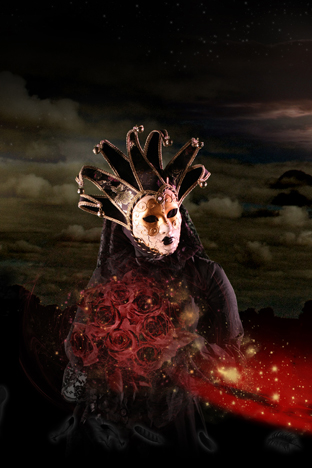
Prima
che della musica, parliamo un attimo dei testi: molto aperti a diverse
interpretazioni ed emozioni, mai banali e scontati: ma perché
in diversi casi avete usato il Tedesco? Alcune delle mie domande sono
nate proprio per la mia incapacità di capire la Vostra lingua,
e me ne dispiace: forse non era meglio l'inglese (o il francese) come
lingua di più facile comprensione per il tipo di musica che
create? O magari (come mi è già capitato di sentirmi
dire da altri gruppi) quei brani non potevano fare a meno di esprimersi/essere
espressi con quel fonema duro e spesso poco 'musicale' della lingua
tedesca?
Amaya:
La maggior parte dei nostri testi sono scritti in Inglese, ma come
hai capito, alcuni brani richiedevano altre lingue. Il suono del linguaggio,
l’intonazione ed il flusso del parlato, specialmente nell’intermezzo
di ‘Alice’ danno un’ulteriore espressione della sensibilità
della storia che viene narrata. Le parole che il coniglio dice ad
Alice suonano più dure e più convulse in Tedesco, proprio
come noi lo avevamo pensato – il ritornello è un po’ più
malinconico. Ma al di là di questo, noi volevamo (e vogliamo)
rendere ogni brano diverso uno dall’altro – e questo include anche
la scelta di usare lingue diverse. E’ proprio un modo di esprimere
le nostre storie in maniera sempre differente.
Ora
veniamo ai due principali CD. Il
primo "Hinter Der Maske Der Schonheit..." (“Dietro
la maschera della bellezza…”) è un album inquieto ed inquietante.
Sia dall'apertura di "The Nightmare Within", e successivamente fino
a "Charonpenny" avverto anfratti ancestrali e malinconici, ritualistici,
epici, con punte mai scontate di potenza creativa, girotondi suadenti
di musica neo-classica: cosa ne pensate di queste mie sensazioni?
Archimed:
Cosa posso dirti? Grande! Quando
io lavoro sulla mia musica, non penso molto al possibile impatto che
un brano potrà avere. Le mie canzoni sono proprio parte di
me, sono un qualcosa di estremamente personale – proprio come un figlio.
Ma vedere i propri figli crescere e contemporaneamente vedere come
la gente reagisce al loro ascolto, è sempre affascinante…
Ma
poi nel disco succede qualcosa: "The Funeral Of A Broken Doll", "Alice"
e "Requiem" sembrano un'unica tragica composizione, forse si riferiscono
ad una stessa Persona...
Kay
Ozz: Vedo che ti appassiona ricercare possibili interpretazioni
;) Mi piace quando le persone iniziano a comprendere i nostri ‘racconti’
e a vederli dal loro punto di vista. Per cui a questa domanda non
Ti risponderò né in negativo né in positivo,
perché la Tua interpretazione non può essere sbagliata
se è proprio l’immagine che hai tirato fuori da te stesso.
Al
di là della Vostra indiscutibile bravura in tutto il disco,
vorrei però approfondire "Alice", il brano che preferisco in
assoluto, l'ho ascoltato e riascoltato senza sosta: ma qui c'è
il problema di cui parlavo prima: di cosa parla esattamente il brano?
Dal testo in generale e dai rumori di macchinari da sala di rianimazione,
sembrerebbero gli ultimi momenti di vita di una giovane ragazza, forse
la 'bambola infranta' a cui avete dedicato anche il DVD... E poi quel
pianoforte, base essenziale capace di esprimere tutto il dolore possibile
di quei momenti... Insomma, cosa è esattamente 'Alice'?
Archimed:
Penso che sia il brano più tragico in tutto ‘Vanitas’. E forse
anche il più criptico. Parla di una madre ed un padre, e la
più terribile tragedia che un genitore debba affrontare: vedere
la propria figlia Alice in coma, in un’asettica stanza di terapia
intensiva. Non sembra esserci alcuna speranza, così i genitori,
in un disperato tentativo, cercano di raggiungere la mente bloccata
della loro bambina prima di arrivare a staccare le macchine che la
tengono in vita. Ma ella è lontana anni luce, in qualche posto
magico della sua infanzia. Non c’è padre, non c’è madre, solo un coniglio
ed una regina. E le loro suppliche affinché Alice torni indietro
prima che sia troppo tardi...
Ammetto
di essermi commosso a più riprese ascoltando il brano, anche
perché purtroppo nella mia vita ho avuto a che fare realmente
con questi luoghi (per me stesso e per mia madre): ma sembra anche
che VOI abbiate vissuto tutto questo come esperienza personale...
Archimed:
E’ vero…
E
se Vi dico che "Requiem" o "Schwester Im Spiegel" mi hanno ricordato
la migliore Anna-Varney, Voi cosa mi rispondete? La stimate come artista
e come 'persona', la rispettate reverenzialmente come me, tanto da
aver accolto delle assonanze specialmente nel comporre ed arrangiare?
Amaya:
Sentirlo dire è un gran complimento per noi. Per quanto mi
riguarda, posso dire che l’ammiro veramente, lei sa creare della musica
meravigliosa!
Il
walzer di "Schwester..." è forse legato a quella "Caroline"
della penultima traccia del cd? E chi è lei? Forse la bambola
preferita di Alice, che muore quando muore la sua padroncina?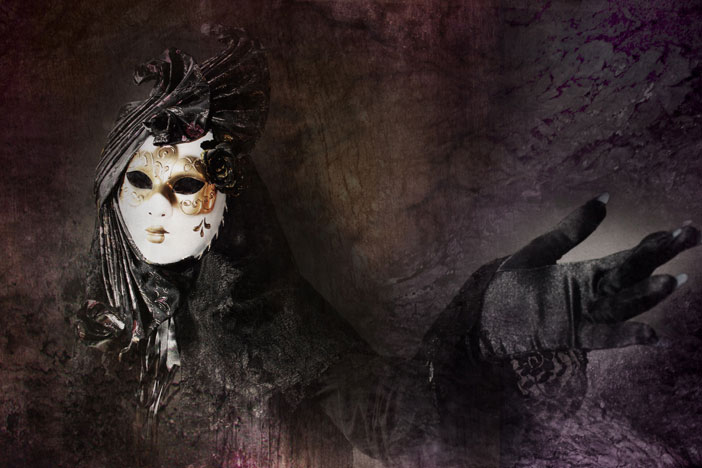
Amaya:
Volevamo lasciare alcuni dettagli aperti alle proprie interpretazioni.
In questo caso si potrebbe forse dire che la ragazza, Alice, che muore
alla fine del brano, diventa la ragazza-fantasma Caroline, imprigionata
nei propri incubi, chiedendosi perché è morta – l’eterna
lotta fra il bene ed il male citata in 'Schwester im Spiegel' potrebbero
essere rappresentate entrambe proprio da lei stessa.
In
"Caroline" citate esplicitamente Freud e le sue teorie, che oggi però
vengono da più parti confutate: penso che abbiate reso omaggio
alla sua "Interpretazione dei Sogni", giusto? E a proposito, il tema
del sogno è ricorrente nell'intero album: allora Vi chiedo
cos'è quello "Spinning Dream" che lo chiude, che inizia con
la (ri)evocazione di un luogo probabilmente immaginario, per poi concretizzarsi
in una sorta di risveglio nel 'vero' mondo...
Amaya:
Hai ragione. E’ l’interpretazione dei sogni, le paure più profonde
ed il subcosciente - Freud una volta affermò che quando perdi
qualcosa, subconsciamente significa che questo qualcosa non era fra
le cose che ti premevano. Se c’è qualcosa di realmente importante
per te, non lo perderesti – è un modo che ha il subconscio
di sbarazzarti di qualcosa che non ti piace. Perciò la prima
parte del brano include questo spoken-word – poiché la piccola
ragazzina morta ‘ha perso la sua vita’. Mi piace veramente la tua
interpretazione di ‘Spinning Dreams’. Effettivamente il brano descrive
il suicidio di una giovane coppia – il ‘sogno’ che viene citato è
l’ultimo viaggio che loro stanno per iniziare. Quindi all’inizio,
il posto immaginario è la realtà in cui essi vivono
– e il risveglio nel mondo ‘reale’ è l’atto della morte e la
resurrezione nel mondo dei morti. Almeno è quello che ci vedo
io.
Il
secondo CD "... Lauert Der Tod" è sicuramente più immediato
da comprendere, più orientato ad una sorta di sperimentazione
elettronica; le 6 parti in cui è suddivisa "RoboterBlut" mi
hanno fatto pensare che se il primo CD rappresenta un mondo interiore
e senza tempo, il secondo sia una rappresentazione più fredda
e futuristica del nostro essere umani...
Amaya:
Hai completamente ragione. Il primo cd è molto più malinconico
ed affronta temi di sentimenti profondi e di sogni, paure e speranze.
Il secondo CD è molto più ‘freddo’, mostra un altro
lato dell’umanità; ‘Missed Calls’ tuttavia crea un legame con
il primo album. I due cd sono come i due lati della stessa medaglia,
o in altri termini i due lati dell’Essere umano.
Una
curiosità: dato che anche nel secondo CD c'è una versione
'di lui' di "Funeral of a broken doll", chi è questo 'lui',
e come compensazione, chi è la 'lei' che ha creato la versione
dello stesso brano nel 1° CD? O si tratta di una scelta diciamo 'schizofrenica'
di sdoppiamento della stessa persona?
Kay
Ozz: La Storia di “Funeral of a broken Doll” è suddivisa
in “Her Version” e “His Version”, ma sono in pratica due diversi personaggi.
“Her Version” racconta la storia dal punto di vista della ragazza,
“His Version” da quello della Morte. Il lato ‘femminile’ è
fragile e leggero, ecco perché compare sul primo cd; “His version”
è più duro e aggressivo e quindi doveva essere sul secondo
CD.
Gli
ultimi brani sono prettamente di trama ethereal/synthpop: se ciò
corrisponde al vero, si è trattato di un modo per stemperare
e sdrammatizzare un pochino la malinconia che requisisce la generalità
delle Vostre composizioni, o è solamente un altro volto dei
'M.F.S.'?
Archimed:
Penso siano stati i brani più divertenti da scrivere. Ricordo
tutte quelle infinite notti al mare. Il vino rosso circolava nelle
tue vene, accendevi la tua sigaretta e ti appoggiavi all’anima che
più amavi o a quella dei tuoi più cari amici Ed aspettavi
i primi bagliori del mattino, sapendo che questo momento non sarebbe
potuto essere migliore. E pensavo che questo poteva essere il modo
migliore per lasciare questo mondo. Nessuna rabbia, depressione, nessuna
ferita aperta – semplicemente andarsene. Se dovessi scegliere il modo
di andarmene – di certo assolutamente sarebbe
questo.
Amo
moltissimo "Chérie" molto anni '80/'90, periodo cui sono indubbiamente
molto legato per motivi anagrafici...
Amaya:
Grazie di cuore. “Chérie” è uno dei brani che anch’io
preferisco – credo che la musica si sposi benissimo con il testo e
mi piace il modo un pò nostalgico che puoi avvertire. La voce
di Kay Ozz ha poi dato al brano una vera anima. Penso che il brano
sarebbe stato giusto per quel periodo.
Adesso
Vi dico una cosa vera: nella nostra webzine "Rosa Selvaggia" io mi
occupo prevalentemente di suoni neoclassici, eterei, darkwave, neofolk,
insomma diciamo che sono il più 'lagnoso' dei Collaboratori:
adesso capirete che preferisco il primo CD al secondo, perché
è molto, ma molto più consimile ai miei reali gusti
e sentimenti... e da qui capirete perché ho amato da subito
'M.F.S.'...
Kay
Ozz: Il più ‘lagnoso’ dei collaboratori – questa è
veramente simpatica! :D Beh, con questo background capisco benissimo
che tu preferisca il primo cd. Ma è proprio questo che mi piace
di ‘Vanitas’: alcuni preferiscono il primo cd, altri il secondo, ed
altri ancora non hanno particolari preferenze: e questo crea diverse
reazioni in chi li ascolta. E, cosa non ultima, non vogliamo essere
inseriti in nessun ‘contenitore’, vogliamo essere liberi di fare ciò
che vogliamo. Perciò è veramente una grande cosa vedere
le diverse reazioni positive sui dischi.
Per
l'album di remix e versioni alternative, lascio invece la parola a
Voi per un commento diretto: ovviamente capisco la presenza dei Das
Ich (anche se, avendo sempre avuto letteralmente 'paura' della loro
violenza musicale...., ho invece apprezzato moltissimo il loro remix),
che cosa mi dite in particolare delle altre collaborazioni, specie
con William Faith che stimo moltissimo?
Kay
Ozz: Ci piacciono tutti i gruppi che hanno remixato per noi, quindi
siamo contenti di queste collaborazioni a “Vanitas” che hanno contribuito
con la loro arte al nostro album.
Il
booklet: già, quel libriccino reale capolavoro di attrazione
e coinvolgimento emotivo: prima di tutto, i disegni sono assolutamente
emozionanti, parlano da soli, ed accompagnano alla perfezione ciascun
brano: non ho però capito se sono tutti di Amaya come citate
in copertina? Ve lo chiedo perché ancora una volta li trovo
assai variegati, passando dal tipico stile gotico a quello cyber (ed
ecco che emerge ancora il concetto di 'personalità multiple'
tanto amato da Bleuer (e in parte da Adler e Freud stesso)...
Amaya:
Sono felice che i miei disegni ti piacciano – e ti confermo che tutti
sono stati create da me. Ho cercato di combinare stili differenti
per catturare le singole atmosfere di ciascun brano – alcuni di essi
richiedevano un’immagine più gotica, altri come ‘RoboterBlut’
avevano bisogno di qualcosa di maggiormente futuristico. Sono orgogliosa
di essere riuscita a realizzare le mie intenzioni.
Sono
un appassionato di manga ed anime, quindi non posso esimermi dal chiedere
ad Amaya e agli altri se li amate anche Voi, considerato il fatto
che molti tratti distintivi dei disegni del libretto mi rimandano
ai migliori lavori giapponesi e coreani...
Amaya:
Ti dirò un piccolo segreto – Io sono una drogata di manga ed
anime! La mia collezione sta facendo scoppiare la mia libreria, e
sono certa che continuerà a crescere sempre più… 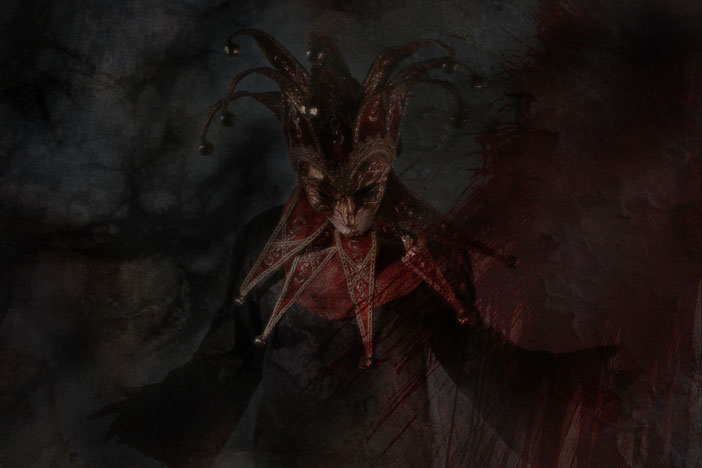
Una
domanda anche sul lungo videoclip di “Funeral Of A Broken Doll”: è
un vero e proprio racconto sempre in bilico fra dura realtà
ed atmosfere immaginarie ed oniriche: come lo avete realizzato? Alcuni
degli attori siete Voi stessi (se me lo potete rivelare)? A rivederlo
oggi, vi emozionate sempre come quando lo avete creato, con la stessa
inquietudine che vi traspare, o lo avete ormai ‘metabolizzato’? Io
personalmente, ogni volta che lo rivedo, scopro qualche particolare,
anche piccolo, sempre differente…
Archimed:
Quando girammo il videoclip, fu importante per me che ciascun pezzo
del puzzle avesse il proprio peculiare significato. Non c’era mai
stata l’intenzione di mostrare il video in televisione e quindi dover
‘competere’ con gli attuali linguaggi con cui la musica può
essere visualizzata. E’ una storia intenzionalmente tranquilla e lenta,
e si è molto riflettuto sul girare il video, perché
esistono di fatto ben rare occasioni dove puoi avere pieno controllo
sia sulla musica che allo stesso tempo sulle immagini Si è
potuto girare con ogni singolo dettaglio, strumento ed accessorio,
in modo da costruirsi il proprio linguaggio espressivo. Abbiamo avuto
alcuni attori veramente bravi – prima fra tutti Simone per la sua
perfetta rappresentazione della ragazza. Non volevamo girare il classico
videoclip dove gli artisti sono i soli protagonisti: così siamo
comparsi solamente in alcuni cammei. A parte Kay Ozz, che ha recitato
la parte della Morte.
Ed
ora per ultime domande, ma non per importanza: le ho lasciate alla
fine perché magari a forza di sentirVele fare, vi sarete stancati
di rispondere... LE MASCHERE. Sono italiano come sapete, quindi è
ovvio che avete tratto ispirazione dal Carnevale di Venezia, che,
inutile dirlo, amo incondizionatamente, ma non nei giorni culmine,
quanto in quelli immediatamente precedenti e seguenti, quando Ti capita
di vagare per le calle, girare un angolo ed imbatterti in queste imperturbabili
e atemporali figure: perché proprio questa scelta artistica?
Come del resto i costumi, anche le maschere li avete disegnati personalmente?
E soprattutto: servono per 'nascondervi' ed essere quindi sempre Voi
stessi, sono un modo per mantenere un certo 'distacco' da chi vi ascolta,
Vi serve per 'proteggervi' dal mondo di oggi? Non credo assolutamente
ad una mera questione estetica, il vostro aspetto è troppo
affascinante e ricco di significati occulti per essere solo frutto
di estetismi modaioli...
Kay
Ozz: Non abbiamo creato noi stessi le maschere, sono originali
di Venezia. Le abbiamo scelte sulla base di quanto ciascuna di esse
potesse rappresentarci al meglio. Ed è vero, al momento ci
stiamo celando al mondo esterno, ma chi oggi non indossa maschere?
Guardati attorno… e guarda dentro di te… Solo che noi vogliamo la
gente con la realtà e non con l’apparenza.
Mi
sembra che ciascun costume rappresenti ciascuno di Voi, oppure li
avete scelti proprio in base alle maschere, come completamento di
una identità anche esteriore?
Archimed:
I costumi e le maschere sono la rappresentazione del nostro io più
profondo. Assieme al nostro vissuto, essi dicono molto più
di qualsiasi altra cosa sulle nostre emozioni e sulla nostra visione
del mondo. Se cominci con questa intenzione, allora devi crescere
all’interno del tuo costume, poiché è la tua seconda
pelle. Noi vediamo le cose attraverso di loro. Perciò è
ovvio che ciascun costume è influenzato dalle nostre personalità.
Quindi è ovvio che i disegni di ogni costume siano in buona
parte influenzati da noi stessi.
Gli
occhi... dalle maschere emergono soprattutto i soli occhi... dalle
foto sembrano perdersi al di là delle spalle di chi vi guarda,
fissando un punto immaginario lontano...
Kay
Ozz: Noi tutti siamo sognatori, noi guardiamo sempre distante,
lontano…
Farete
dei concerti anche qui in Italia? Da noi la scena è desolatamente
poco viva per certe proposte difficili come la Vostra (e Vi parla
di chi ha preso parte viva nell'organizzazione del concerto dei “Jack
or Jive”, per dire un nome...): dal vivo dovreste essere uno spettacolo
per l'anima ed il cuore, una serata onirica... almeno per quel poco
che gira sulla Rete...
Archimed:
La situazione dei live è effettivamente un pò più
complessa, perché noi vogliamo essere sicuri che i concerti
trasferiscano le visioni che avevamo in mente per ‘Vanitas’, nel mondo
reale. Abbiamo avuto questa possibilità al Wave Gotik Treffen
2010 a Lipsia ed è stato veramente un evento ispirato. Ma come
per ogni idea ‘fuori dal comune’ hai sempre bisogno di pazienza, tempo,
e costanza. Ma questo ripagherà chi ci segue – promesso!
E
un intero DVD live? Oppure, meglio, con un video per ciascuna delle
Vostre affascinanti canzoni? Ne avete mai parlato, oppure l'avete
scartato a priori visti che al solito si tratterebbe di costi troppo
ingenti?
Kay
Ozz: La creazione di un DVD live o la produzione di altri videoclip
sono sicuramente nella nostra lista di cose prioritarie da realizzare.
Ma abbiamo centinaia di idee e ci vuole tempo per realizzare tutto…
Bene,
mi sembra di averVi chiesto tutto, a Voi concludere come faccio sempre,
con un piccolo personale pensiero... o magari una domanda che avreste
voluto sentirVi fare…
Amaya:
Grazie mille per questa fantastica intervista! E’ raro trovare qualcuno
che capisca l’essenza delle nostre composizioni fino a questo punto.
Spero
che un giorno potremo incontrarci ad un concerto :)
Grazie
del tempo che mi avete concesso, auguri per la Vostra carriera, a
risentirci!
Siti
Web:
www.myspace.com/myfriendskeleton
www.my-friend-skeleton.com
|
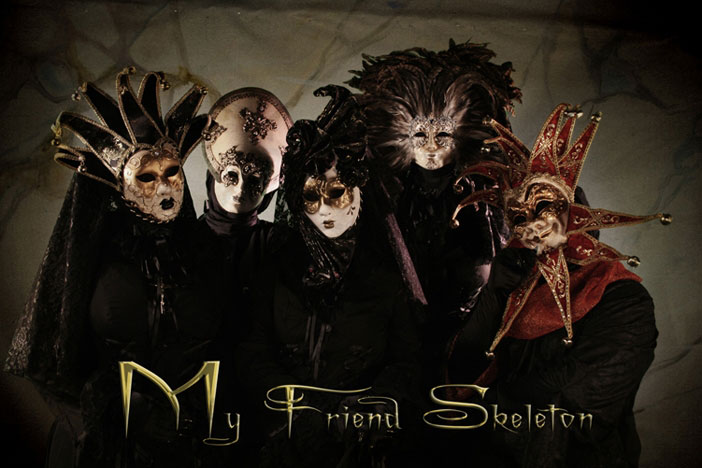
Interview
by Anialf
I
thought I had seen and heard it quite all, in my longstanding
commitment in the so-called ‘gothic
scene’: never
be conceited, there’s
always something new to learn (and I hope there will be forever).
And people who had the excellent and worrying idea to coming
closed to “My Friend Skeleton”, my guests on this interview,
and to their last work “Vanitas”, will give me right. Stop now,
let’s start
with my questions, never enough for me... even because this
is not only a simple interview, but also a review of “Vanitas”
at the same time…
First
of all, thank you in advance for this chat. As I already wrote
in the Intro, I’d
never have believed to find something really original and, most
importantly, really involving and emotional. So then, my very
first question is also the most trivial: who (or ‘what’)
are “My Friend Skeleton”? How did your start and what particular
reasons and perspectives did you looked for? Where do you came
from, both physically and visionary?
Archimed:
Ok, I think I start with the easy one. We are or were creatures
from Earth, third planet of the solar system near Proxima Centauri
:-) Seriously - the roots of all members of the skeleton family
diverge largely. We are all European but are not limited to
it. That's one of the reasons why we are wearing masks: We don't
want the people to focus on our background or origins - we want
to communicate through our art. As soon as we have established
this line of communication we will reveal more of our background.
The
founding members of the skeleton family met some years ago.
We wanted to create an artistic family where the bounds were
related more by common sense of art than by blood. We started
with Amaya, Kay Ozz, Serena, Violetta and me. And for every
artistic family it's a very active arrival and departure - Serena
and Violetta stayed during Vanitas, Leontes visited us for a
short time, Asuveideto is currently playing the drums and there
are even more members who will be revealed in the upcoming projects.
And therefore there is always a source for so many different
projects: My Friend Skeleton and My Skeleton Friend - obviously
the most prominent ones - are only the first ones in a hopefully
long list of follow-up collaborations: Sometimes it's a family
trip, sometimes it's a more private project just with a brother
or sister.
I’d
have to be honest: I opened your special-box, sensing immediately
its arcane contents, but I never expected to find a similar
masterpiece, a visual and acoustic joy/torment. Then I saw the
“Danse Macabre” label and I thought << Bruno Kramm, who
else? >> And I read his introduction in the first page
of the book: tell me, how Bruno acted with his lucid creative
madness in the album? Does he help directly to realize ‘Vanitas’
or he was only your producer? Did he also discovered you, since
that it wouldn’t
be the first time that his musical instinct leads him for the
better, and finally how did you contact him?
Kay
Ozz: We realized and produced the album by ourselves. But
from the beginning of our collaboration Bruno really supported
our ideas. It was great to see that our ideas fell on a fertile
ground. And so it happened that Bruno wrote the introduction
of our book. We are really happy about that because we appreciate
him very much and are very happy about his support. 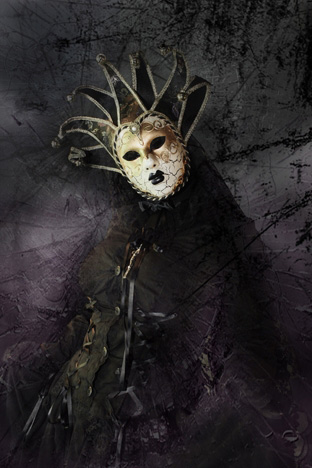
Reading
your amazing booklet (to whom I’ll
talk later) It seems that, although you appear as a real band,
Archimed is the main person behind 'M.F.S.', when the other
components have contributed with their basilar help: am I right,
or anyway “Vanitas” has been a fairly equal work?
Archimed:
I wouldn't call myself the main person behind My Friend Skeleton
but due to the natural split of work I may have the most influencing
part. Being a musician and composer since I can remember my
share of work was to build and decorate the stages for all the
incredible stories Amaya wanted to tell. And without the fabulous
voice talents of Kay Ozz and his different approach to music
My Skeleton Friend (our alter egos at the second half of Vanitas)
wouldn't have been possible.
As
far as writing music for Vanitas is concerned I always need
my space and time for building the landscapes for the stories.
Writing music has much in common with writing for films or books.
First of all you need a haunting story. Then you have to come
up with an interesting stage, you need to find the protagonists
(in my case the instruments and sounds) and you have to pull
them all together. Personally every instrument, every sound
and every note has it's own meaning to me.
The
box contains even 3 cds of original songs, 1 cd of remixes of
yourselves and other bands, and especially the astonishing long
videoclip of "Funeral of a broken doll" song: the entire work
is called 'Vanitas': why? What do you mean with this word, to
be taken or not literally?
Kay
Ozz: The album is called Vanitas because it describes the
deeper sense that connects the storys with each other. All the
storys show the momentariness of life. They present a point
of view on the death from different positions.
Before
that music, let’s
talk a bit about lyrics, very opened to different interpretations
and feelings, never trivial or assumptive: but… why in some
cases did you used the German language? Some of my questions
were born just for my failure to understand your language, and
I’m sorry of
that. Maybe it was better English (or French) as a language
of easier interpretation for the kind of music you create? Or
maybe (as other bands told me in these years) those songs could
not do without being expressed with the typical hard and often
little musical of German language?
Amaya:
Most of our lyrics are written in English, but as you metioned,
some songs just ask for other languages. The sound of the language,
the intonation and the stream of speech, especially in the bridge
of 'Alice' gives an extra expression of the feeling of the story
that is told. The words that the rabbit says to Alice sound
harder and more hectic in German, just as it was intended -
the refrain a little more melancholic. But even beyond that
we want to try to make our songs different from each other -
including different languages. It's just a way to express our
stories in even more different ways.
Now
let’s
talk about the main cds. The first „Hinter Der Maske Der Schonheit...“
is a very anxious, tormented and worrying. Right from opening
"The Nightmare Within", and up to "Charonpenny" I feel ancestral,
mirthless, ritualistic and epical gorges, with never assumpted
signs and movements of creative force, and suasive circles of
neo-classical: what do you think about all of these personal
feelings?
Archimed:
All I can say: WOW. When I work on music I don't spend much
thoughts on the possible impact a song may have. For me songs
are part of me and something very personal - like children.
But to watch the children grow up and to see how people react
on them it's always fascinating. 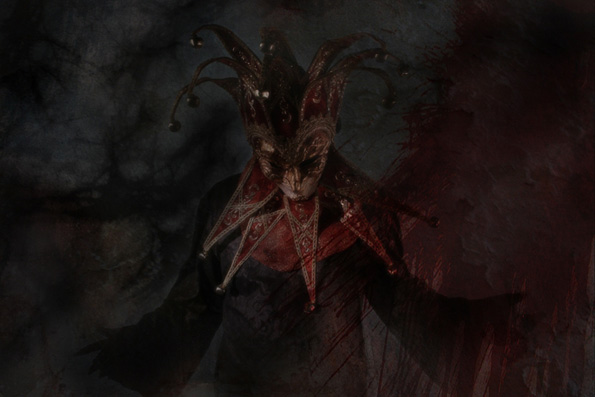
But
then, in the album, something happens: "The Funeral Of A Broken
Doll", "Alice" and "Requiem" remind me of a single tragically
composition: perhaps they refer to the same Person…
Kay
Ozz: I see, you are a fan of interpretations ;) I like it
when people start to grab the story and see them through their
own point of view. So I won't give you an answer about right
or wrong because your interpretation can't be wrong if it is
the statement you draw out for yourself.
Beyond
your undeniable talent in the entire work, I’d
like to deepen the track "Alice", my absolute favorite song,
I listened and listened it relentlessly: but here’s
the problem of the German lyrics: exactly, what is it talking
about? Reading the text at large, and from the noises of typical
intensive-room machineries, it would seem the last moments of
a young girl’s
life, maybe the ‘broken
doll’ to which
you have dedicated the DVD, too… And then that piano, essential
background able to express all the possible pain of those moments…
In short, what is exactly ‘Alice’?
Archimed:
I think that's the most tragic song on Vanitas. And maybe the
most cryptic. It's about a father and a mother and the most
terrible tragedy parents have to face: To see their daughter
Alice in coma at the intensive care station. There seems no
coming back so the parents try in a desperate attempt to reach
their daughter's locked mind before they have to pull the plug
of the life support. But the daughter is light years away in
some magical place from her childhood. There is no father, there
is no mother, just a rabbit and a queen. And their pleadings
for Alice to go back because time is running out...
I have to admit that I moved several
times listening to this song, also because unfortunately in
my life I really had to do with these places (for myself and
for my mother): but it seems that ma even you have lived a sort
of these things as personal experience…
Archimed:
That's true.
And
if I tell you that "Requiem" or "Schwester Im Spiegel" remind
me of the best Anna-Varney, what is your opinion about? I admire
her both as artist and ‘person’,
is the same for you, so by accepting some assonances especially
in the way of composing and arranging your music?
Amaya:
Hearing this is really a big compliment for us. As for me I
can say that I really admire her as well. She makes amazing
music!
The
waltz of "Schwester..." is maybe related to that “Caroline”
of the homonymous song? And who is she? Maybe is she the preferred
Alice doll, that dies at the same time Alice dies?
Amaya:
We wanted to leave some details open for personal interpretation.
In this case you could perhaps say that the girl, Alice, who
dies in the end of the song becomes the ghost girl Caroline,
imprisoned in her own nightmare, wondering why she died - the
internal fight between the good and the bad side mentioned in
'Schwester im Spiegel' could be the same girl as well.
In "Caroline" you explicitly quote
Freud and his theories, which nowadays are refuted by several
analysts: I think that you have especially his "The Interpretation
of Dreams", am I right? And by the way, dream is a returning
theme in your songs, so I wonder what is that “Spinning Dream”
that close the album; it’s
a song that begins with a recalling of an imaginary place (maybe…)
and at the end takes the form of a sort of awakening in the
‘real’
world…
Amaya:
You are right. It is the interpretation of dreams, inner fears
and the subconsiousness - Freud once stated that when you lose
something, it subconciously means you didn't want to have it
in the first place. If it really was precious to you, you wouldn't
have lost it - it was just a subconcious way to get rid of something
you didn't like. So the first part of the song includes this
kind of word-play - because the little dead girl 'lost her life'.
I really like your interpretation of 'Spinning Dreams'. Actually
it describes the suicide of a loving couple - the mentioned
'dream' is the last journey they are about to start. So in the
beginning, the imaginary place would be the reality in which
we are living - and the awakening in the 'real' world would
be the act of dying and the rebirth in the world of death. I
really like this thought.
The
second CD "... Lauert Der Tod" is surely more understandable
and comprehendible, more oriented to a sort of electric/electronic
experimentation; the six parts of "RoboterBlut" made me think:
if the first cd could represent an inner and timeless world,
the second one is a colder and futuristic representation of
our being human…
Amaya:
You are totally right. The first cd is much more melancholic
and handles themes of inner feelings and dreams, fears and hopes.
The seconds cd is much colder. It shows another side of the
human race. 'Missed Calls' however links back to the first cd.
The two cds are like two sides of a medal, or two sides of a
human being.
A
curiosity: since in the second cd, too, there’s
a ‘him version’
of “Funeral of a broken doll”, who is ‘him’?
And as a sort of balancing, who is the ‘her’
that created the own version of this song in the first cd? Or
maybe is a 'schizophrenic' kind of splitting of the same person?
Kay
Ozz: The Story of “Funeral of a broken Doll” is splitted
up into “Her Version” and “His Version”. But this are really
two characters. “Her Version” tells the story from the point
of view of the girl, “His Version” from the point of view of
the death. The female side is fragile and soft; that's why it
appears on CD 1. His version is harder and rougher and is on
CD 2.
The
last songs have a strictly ethereal/synthpop sound: if you agree
with me, it was a way to soften and defuse the lonesomeness
that seize mostly of your compositions, or is it just another
face of “M.F.S.”?
Archimed:
I think this was the song I had most fun to write. I remembered
all the endless nights at the sea. Red wine circulates through
your blood, you light your cigarette and lean against the soul
you love or dear friends. And you wait for the first signs of
the morning and you know that this moment can't get any better.
And I think this would be the best way to leave earth. No anger,
no depression, no open wounds - you just let go. If I had to
choose the way how to leave - that's would definitely be it.
I love to death “Chérie”,
very eighteen/nineteen style, a period which I’m
linking a lot for my age…
Amaya:
Thank you very much. Chérie is one of my favourite songs
as well - I think the composition fits really well to the lyrics
and I like the way it sounds a little nostalgic. The way Kay
Ozz' voice fits into the song gave the lyrics a soul. I think
the song would have fit perfectly into this period of time.
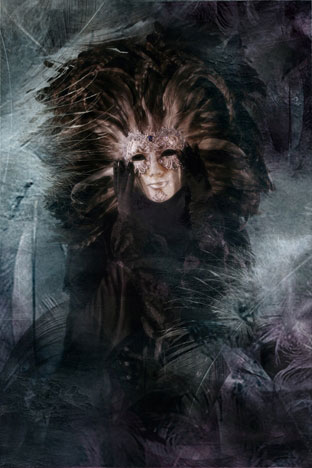
Now
I want to reveal you one thing: in our webzine “Rosa Selvaggia”
I’m
usually attending to neoclassical, ethereal, darkwave, neofolk…
in short you can refer me as the most ‘whining’
collaborator hehehe. Now you can understand that I prefer your
first cd to the second, because more similar to my real taste
and feelings… and finally you’ll
understand why I love immediately “M.F.S.”!
Kay
Ozz: The most whining collaborator - that's really cool
:D
Yes, with this background I can totally understand that you
prefer CD 1. But this is a fact that I like about Vanitas. Some
people prefer CD 1, some people prefer CD 2 and some are equal.
That brings a lot of different reactions. And last but not least
we don't want to be put in a drawer, we want to do whatever
we want. So it is really great to see the positiv reaction on
that.
For
the remixes and alternative versions album, I give the word
to you for a direct comment: naturally I understand the presence
of Das Ich (even if, having scared of their musical violence
hehehe… on the contrary I really appreciated their remix very
much), but what about the other collaborations, especially with
William Faith that I appreciate a lot?
Kay
Ozz: We appreciate all the bands that remixed us. So we
are really happy that they accompanied Vanitas and gave us a
masterpiece of art to round our album up.
The
book: yes, that little real masterpiece book, full of attraction
and emotional involvement: above all, the drawings speak for
themselves, and matching each song perfectly: nevertheless I
couldn’t
understand if they were all created by AMAYA SAKINAH as you
quoted in the cover? I ask you this, because I found them very
varied, moving from traditional gothic style to a more oriented
cyber (and that emerges here again the concept of “multiple
personalities”, so loved by Bleuer (and partly by Adler and
the Freud himself)...
Amaya:
I'm really happy you liked my drawings - and yes, all of the
included pictures are made by me. I tried to combine different
styles to catch the unique atmosphere of each song - some songs
required an image that is more gothic, others like 'Roboterblut'
were way more futuristic. I'm really glad I accomplished this
intention.
I’m
an avid reader of anime and manga, so then I can’t
avoid asking AMAYA and all of you, if you still love it, considering
the fact that many hallmarks of the book remind me of the best
Japanese and Korean works…
Amaya:
To tell you a little secret - I really am a manga and anime
addict. My collections bursts my shelves and I'm sure it will
continue growing^^
One
question about the long video clip of “Funeral Of A Broken Doll”:
to me, it seems a true story, always somewhere in between hard
reality and imaginary atmospheres: how did you make it? Some
of the actors are you (if you can reveal me)? To see it over
time, are you still excited as when you shoot it, with the same
anxiety, or by now you ‘metabolize’
it? Personally, each time I see it, I found some little new
peculiarities always different…
Archimed:
When shooting this clip it was important to me that all the
little pieces of the puzzle have their own meaning. There was
never the intention of the movie to be played in television
and compete against the current language of music visualization.
It's an intentional quiet and slow story. And it was very deliberating
to shoot this video. Because there are only some rare occasions
where you have control over music and images at the same time.
You can play with all little details and connect instruments
and accessories and build on top of that some sort of own language.
We
had some really good actors - first of all Simone to mention
for her perfect representation of the girl. We didn't want to
shoot a typical band video where the artists takes all the screen
time so we did just short cameos. Except Kay Ozz - who played
the part of the Death.
And
now for the latest questions, but not in order of importance:
THE MASKS. As you know I’m
Italian, so it’s
natural for me thinking that you found inspiration from Venice
Carnival, that, obviously, I absolutely love it. But not in
the highlight days, but rather immediately before and after,
when you happen to wander the typical venetian streets, turning
a corner, and bumping in one of these phlegmatical and atemporal
figures: why precisely this artistic choice? As for the costumes,
you personally created your own masks? And, what is most important,
masks are used for 'hiding' yourselves, therefore for always
being yourselves at any time, are a way to maintain a certain
aloofness from your listeners, are a way for 'protect' yourselves
from nowadays world (sort of self-barrier)? I absolutely don’t
think that your clothes are a mere question of aesthetics, your
look is too much attractive and rich of cryptical meanings,
to be the result of fashion choices…
Kay
Ozz: We didn't create these masks ourselves. They are truely
venecian. But we choose those masks that express ourselves most.
Yes,
at the moment we are hiding ourselves from the world outside.
But isn't everybody wearing masks? Look around. And look at
yourself. We just confront people with the reality.
I think that each costume represents each of you, or you have
chosen it according to the masks, as a completion of an exterior
identity?
Archimed:
The costume and masks are the representations of our inner self.
Together with our biography they tell much more about our emotions
and visions than anything else. If you start with this intention
of course you have to grow into your costume because it's your
second skin. And it's our personal way of seeing things. So
it's obvious that each design of costume is personally influenced
by a large extent.
The
eyes… from the masks they emerge above all… from your images
it seems that they’re
loosing just above the shoulders of those who are watching you,
staring on an imaginary point away…
Kay Ozz: We are dreamers. We always look into the distance.
Are
you planning some live performance in Italy, too? In my Country
goth scene is unfortunately not alive as in Germany, at least
for certain ‘difficult’
proposal as your music (and I took part in the past to the organization
of a Jack or Jive concert, to name one…): on stage you should
be a continue emotion for the soul and the heart, an oniric
night… al least for what little I saw on Internet…
Archimed:
The live situation is currently a little bit complicated because
we want to ensure that concerts transfer the visions we had
in mind for Vanitas to the real world. We had this chance for
the Wave Gotik Treffen 2010 in Leipzig and it really was some
inspired event. But for extravagant concepts you always need
patience, time and tenacity. But it will pay out - promised!
And
what about the idea of an entire live DVD? Or, better, with
a videoclip for each of your charming songs? Have you never
spoken about it, or do you have discarded this idea for budget
problems?
Kay
Ozz: Making a live DVD and producing more videoclips are
thigs that are definitely on our to-do list. But we have hundreds
of ideas and it takes time to realize all of them...
Well,
I think I asked you everything… Close this interview the way
you wish, with a little thought or maybe with a question I missed…
Amaya:
Thank you very much for this amazing interview! It is rare to
find someone who understood the essence of our songs in such
a way. I hope one day we will meat each other on a concert :)
Thank
you again and again for the time you reserved to me, best wishes
for your success and career, see you soon!
www.myspace.com/myfriendskeleton
www.my-friend-skeleton.com
|
|